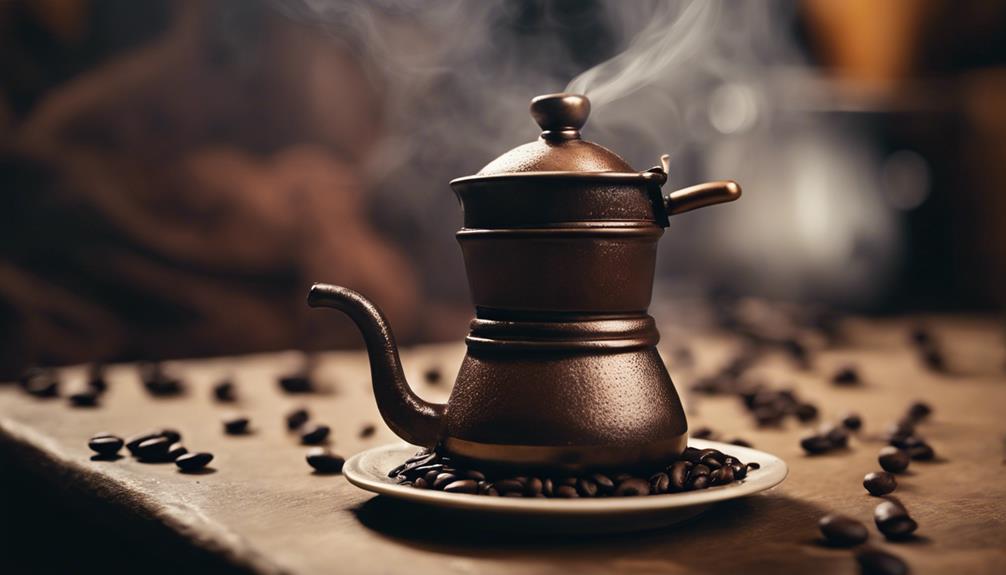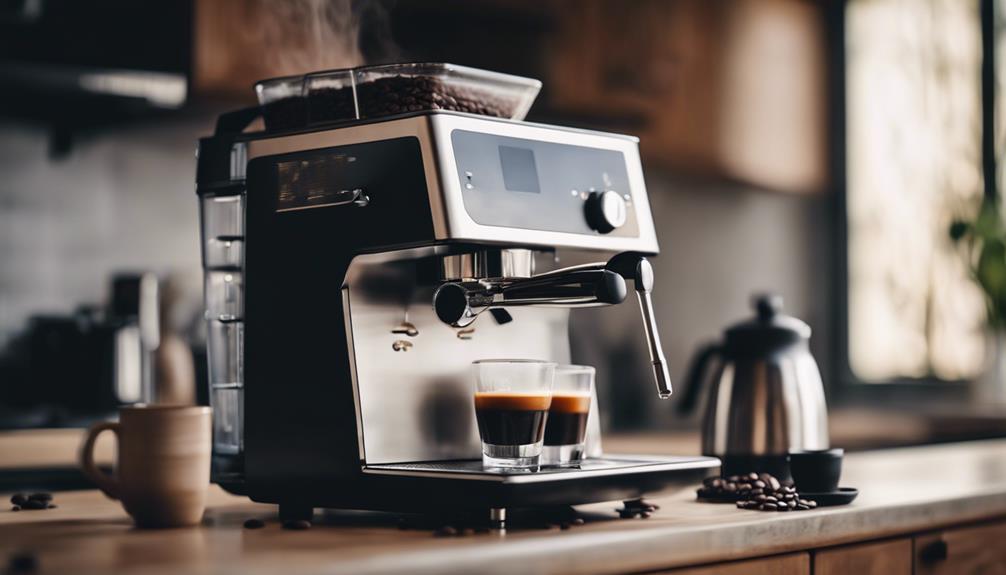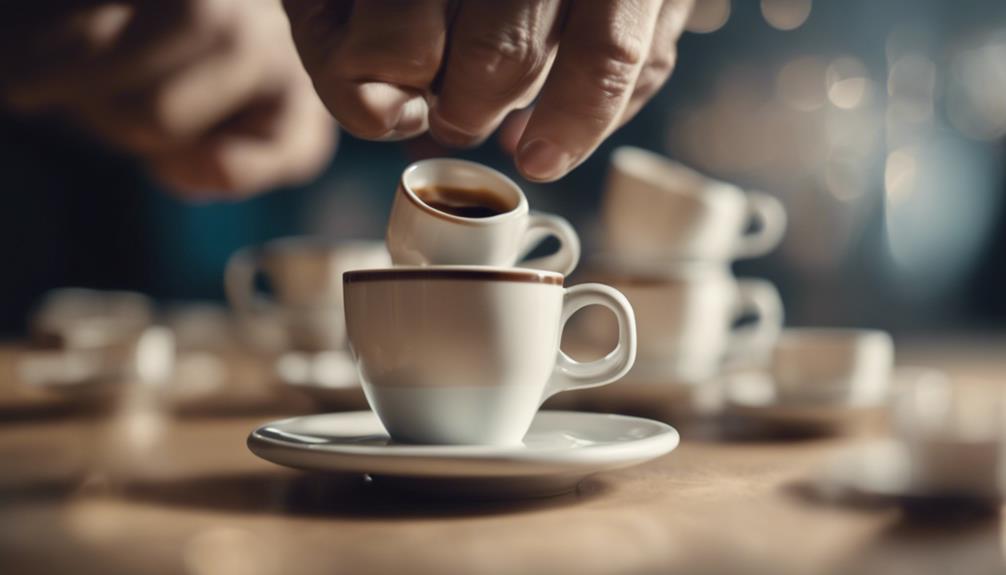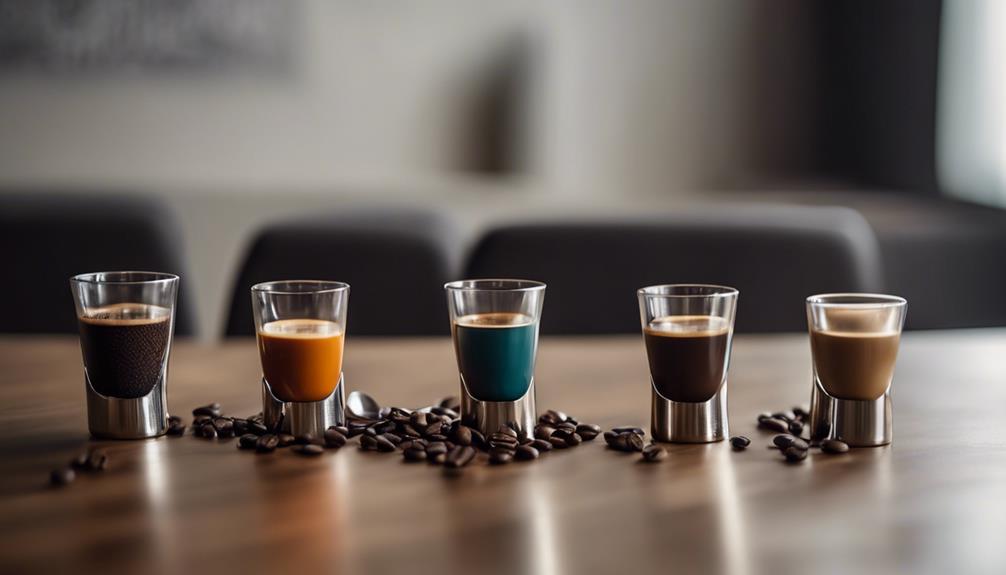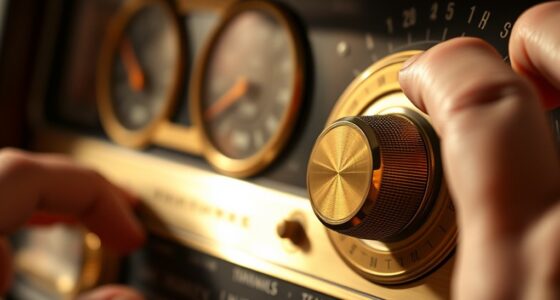Turkish coffee is often considered stronger than espresso, primarily due to its higher caffeine content per serving. While Turkish coffee contains 40-60 milligrams of caffeine, espresso has around 63 milligrams per shot. The distinct flavor profiles also play a role in this perception, with Turkish coffee known for its bold, intense flavor and sweetness, contrasting with espresso’s potent taste, typically unsweetened. Variations in brewing methods, roasting techniques, aroma intensity, cultural significance, and health implications further differentiate these two popular brews. To gain more insights into the nuances between Turkish coffee and espresso, explore the detailed comparisons provided.
Key Takeaways
- Turkish coffee's slow extraction creates a full-bodied taste, often perceived as stronger than espresso.
- Espresso's high-pressure extraction yields intense flavor quickly, but Turkish coffee is richer in taste.
- Turkish coffee's medium roasting enhances its boldness, surpassing espresso's intensity.
- Turkish coffee's rich aroma and sweetness contribute to its perceived strength compared to espresso.
- Despite espresso's quick extraction and potency, Turkish coffee's brewing process results in a stronger flavor.
Caffeine Content Comparison
Typically, Turkish coffee contains 40-60 milligrams of caffeine per serving, while Espresso has around 63 milligrams per shot. The caffeine content in Turkish coffee can vary based on the brewing method, bean type, and serving size.
Turkish coffee's caffeine level is influenced by the traditional brewing process that involves simmering finely ground coffee beans. On the other hand, Espresso is known for its concentrated caffeine content, providing a quick and potent energy boost in just a shot.
Both Turkish coffee and Espresso derive their strength and intensity of flavor from the caffeine content present in each brew. While Turkish coffee offers a slightly lower caffeine concentration per serving compared to Espresso, the brewing method and ritualistic preparation contribute to its robust flavor profile.
Understanding the caffeine distinctions between Turkish coffee and Espresso can help you choose the perfect brew based on your preferred intensity and energy requirements.
Flavor Profile Distinctions

Explore the distinct flavor profiles of Turkish coffee and Espresso to understand how their taste experiences differ. Turkish coffee is renowned for its strong and bold flavor, often complemented by a rich aroma that captivates the senses. This traditional brew is known for its robust and full-bodied characteristics, making it a favorite among those seeking a rich coffee experience. In contrast, Espresso offers an intense and concentrated flavor profile, achieved through a high-pressure brewing method that results in a powerful taste sensation. While Turkish coffee tends to be sweeter and bolder, Espresso leans towards a more intense flavor that can sometimes carry a hint of bitterness. Here's a comparison table to highlight the flavor profile distinctions between Turkish coffee and Espresso:
| Turkish Coffee | Espresso | |
|---|---|---|
| Flavor Profile | Strong, bold, intense | Intense, strong, bold |
| Aroma | Rich, inviting | Potent, aromatic |
| Sweetness | Sweetened with sugar | Generally unsweetened |
Brewing Process Variations

To understand the differences in brewing process between Turkish coffee and Espresso, consider the distinct methods used for creating these renowned coffee beverages.
Turkish coffee involves grinding Arabica or Robusta beans into a fine powder and then mixing it with water and sugar. This mixture is heated and stirred before serving, allowing for a slow extraction process that takes 5-10 minutes.
On the other hand, Espresso is made by forcing hot water through finely-ground Arabica beans under high pressure, resulting in a quick extraction process that lasts under 30 seconds. This high-pressure method fully extracts the flavors and caffeine from the coffee beans, creating a concentrated and intense flavor profile.
Turkish coffee, with its medium roasting and longer brewing time, offers a full-bodied and strong taste, while Espresso, due to its high-pressure extraction, delivers a bold and robust flavor experience.
Roasting Techniques
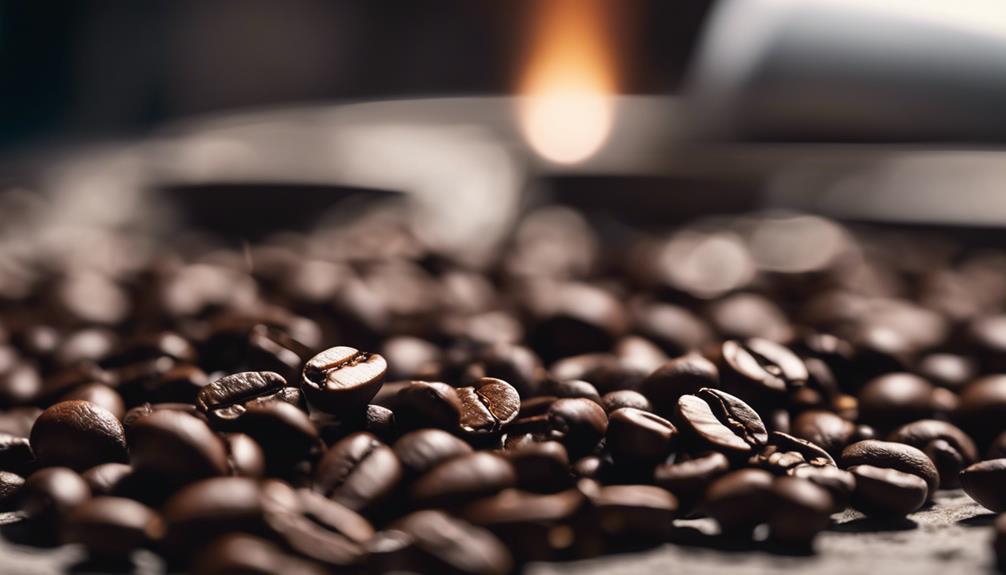
For both Turkish coffee and Espresso, the choice of roasting technique greatly influences the final flavor profile and strength of the brew. Turkish coffee benefits from a medium roasting level, which efficiently extracts flavors during the brewing process.
In contrast, Espresso requires a dark roast to achieve its intense and concentrated flavor profile. The roasting techniques employed for Turkish coffee and Espresso are specifically tailored to bring out their distinct flavor profiles.
Roasting levels play an essential role in directly impacting the taste and strength of both brews. Understanding the roasting process is pivotal in determining the strength and boldness of Turkish coffee in comparison to Espresso.
Aroma Intensity Differences
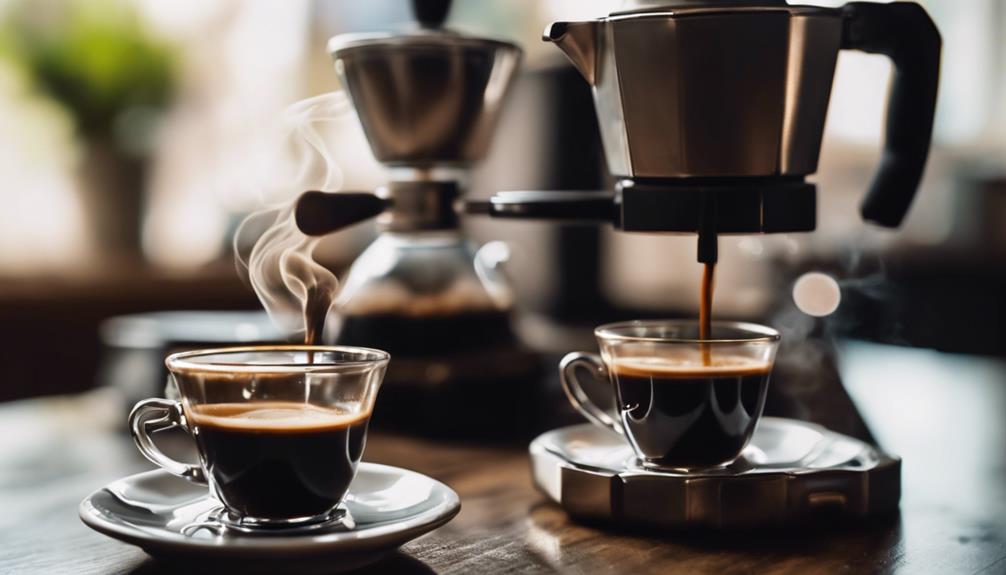
Turkish coffee's aroma is distinct for its rich and full-bodied qualities, while espresso boasts a deep and robust scent.
The medium-roasted beans and traditional brewing method of Turkish coffee contribute to its aromatic richness.
In contrast, espresso's high-pressure extraction process and dark roast create a concentrated aroma profile.
Aromatic Richness Comparison
With a bold and intense flavor profile, the aromatic richness of Turkish coffee surpasses that of Espresso due to its traditional brewing process.
The tradition of drinking traditional Turkish coffee involves a unique method of boiling finely ground coffee beans, which enhances its aroma intensity. This process results in a rich and robust scent that's sweet and slightly spicy, adding to the coffee's overall sensory experience.
While Espresso also boasts an aromatic profile, it tends to have a more concentrated and potent aroma compared to Turkish coffee. The rich aroma of Turkish coffee plays a significant role in why it's perceived as stronger than Espresso both in flavor and fragrance.
It's this distinct aromatic richness that sets Turkish coffee apart and contributes to its reputation as a bold and flavorful beverage. So, if you're seeking a coffee experience with a deep and complex aroma, traditional Turkish coffee might just be the perfect choice for you.
Brewing Process Impact
When comparing the aroma intensity differences between Turkish coffee and Espresso, the brewing process plays an essential role in shaping the distinct fragrance profiles of each beverage. Turkish coffee's grounding coffee beans are simmered with water and sugar, resulting in a rich and intense aroma that's complex and full-bodied.
In contrast, Espresso's high-pressure brewing method creates a concentrated and bold aroma, characterized by its robust and sharp fragrance. The slow brewing process of Turkish coffee allows for a thorough extraction of flavors and oils from the beans, contributing to its earthy scent.
On the other hand, Espresso's high-pressure brewing technique extracts the essence of the coffee beans swiftly, resulting in a distinctive and intense aroma that sets it apart from Turkish coffee. The differences in brewing techniques between these two methods notably impact the aroma intensity and overall sensory experience of each beverage.
Cultural Significance

Turkish coffee plays a significant role in Turkish culture, symbolizing deep-rooted traditions and fostering social bonds through its ceremonial consumption.
The rich history of coffee rituals in Turkey showcases the importance of hospitality and friendship in the Turkish community.
From the preparation to the serving process, Turkish coffee embodies a cultural tradition that goes beyond just a simple beverage.
Coffee Rituals in Turkey
How deeply ingrained are the cultural rituals surrounding coffee in Turkey?
Turkish coffee holds a significant place in Turkish culture, where it goes beyond just a beverage to become a symbol of tradition and hospitality. The coffee rituals in Turkey aren't merely about the act of drinking coffee; they're about fostering connections and social interactions.
Here are some aspects of the coffee rituals in Turkey that make them so special:
- Cherished and Consumed: Turkish coffee isn't just a drink but a tradition that's deeply cherished and consumed by many Turks daily.
- Tradition and Hospitality: The brewing and serving of Turkish coffee are steeped in tradition, often used as a way to show hospitality and warmth to guests.
- Customs and Rituals: Specific customs and rituals surround the preparation and serving of Turkish coffee, making it a unique experience.
- Enhanced Enjoyment: Enjoying Turkish coffee with sweet treats like Turkish delight adds to the overall experience, making it a delightful ritual.
In Turkey, the practice of sharing Turkish coffee goes beyond a simple drink; it's a cultural tradition that brings people together.
Social Bonding Tradition
Embracing the cultural significance of social bonding traditions, the shared experience of enjoying Turkish coffee or Espresso fosters connections and strengthens relationships in distinct ways.
Turkish coffee, deeply ingrained in Turkish culture, symbolizes hospitality and unity. Served with water and sweet treats like Turkish delight during gatherings, it encourages leisurely conversations and shared moments among friends and family.
In contrast, Espresso, a staple in Italian culture, is often consumed as a quick energy boost or a social drink in bustling cafes. While both beverages promote social interactions, there are major differences in the rituals surrounding them.
Turkish coffee emphasizes savoring the moment and engaging in meaningful conversations, while Espresso requires a swift consumption, reflecting the fast-paced Italian lifestyle. Despite these contrasts, the essence of social bonding remains at the core of both traditions, enriching relationships and creating lasting memories over a cup of coffee.
Health Implications

With its higher caffeine content, Turkish coffee can impact your health in various ways compared to Espresso. Here are some health implications to keep in mind:
- Increased Alertness: Turkish coffee's higher caffeine content can lead to increased alertness and energy levels.
- Moderation is Key: While both Turkish coffee and Espresso have health benefits, moderation is vital to avoid potential negative effects of caffeine consumption.
- Intense Flavor Profile: The rich and bold flavor profile of Turkish coffee may be more intense than the concentrated taste of Espresso.
- Strong Caffeine Boost: Consuming Turkish coffee in moderation can provide a stronger caffeine boost than a shot of Espresso.
Considering these factors, it's important to be mindful of your caffeine intake, especially when consuming beverages like Turkish coffee that pack a stronger punch. Balancing enjoyment with moderation is critical for reaping the benefits without experiencing adverse health effects.
Frequently Asked Questions
Is Turkish Coffee the Strongest Coffee?
Turkish coffee is renowned for its strength due to the fine grind and extended brewing process. The bold flavor and high caffeine content make it a potent choice for coffee enthusiasts.
While other coffee types exist, Turkish coffee stands out for its robust taste profile. With its traditional brewing method and intense flavor experience, Turkish coffee is indeed considered one of the strongest coffee options available.
Which Coffee Is Stronger Than Espresso?
When comparing coffee strength to Espresso, Turkish coffee stands out for its bold flavor and higher caffeine content.
The traditional brewing method of Turkish coffee results in a potent taste profile and rich aroma.
While Espresso is known for its concentration, Turkish coffee's longer extraction process allows for a more robust sensory experience.
Does Turkish Coffee Have More Caffeine?
Turkish coffee contains around 40-60 milligrams of caffeine per serving. Espresso, on the other hand, packs approximately 63 milligrams per shot. Espresso edges out Turkish coffee in caffeine content, making it slightly stronger in regards to caffeine intake.
This disparity in caffeine levels contributes to the varying strengths and intensities of these two popular coffee types. Understanding these differences can help you make an informed choice based on your preferred caffeine intake level.
Which Is Stronger Turkish or American Coffee?
American coffee and Turkish coffee differ in strength due to their brewing methods. American coffee is brewed through methods like drip or French press, resulting in a milder flavor compared to the intense and concentrated taste of Turkish coffee.
Turkish coffee's unique brewing process, where the grounds are left in the cup, contributes to its robust flavor profile, making it stronger than American coffee.
Is Turkish coffee really stronger than espresso?
When it comes to the espresso vs turkish coffee comparison, many people believe that Turkish coffee is stronger due to its fine grind and unfiltered brewing process. However, the brewing method and the coffee bean type can affect the strength of the final cup, making the comparison not so clear-cut.
Conclusion
To sum up, Turkish coffee offers a stronger caffeine kick than espresso, with a bolder flavor profile and unique brewing process. The cultural significance and aroma intensity add to the overall experience, making it a popular choice for coffee enthusiasts.
Whether you prefer the rich flavors of Turkish coffee or the intense jolt of espresso, both options offer distinct characteristics that cater to different preferences. Ultimately, the choice between the two comes down to personal taste and cultural appreciation.
